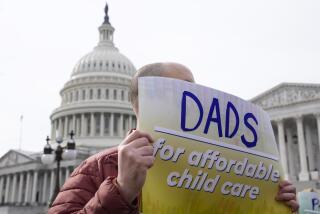Welfare Reform That Makes Poor Kids Poorer Will Never Pay Off
- Share via
Both the Senate and the House have now passed welfare reform bills. A conference committee will now combine the two versions and send the result to President Clinton. The smart money is betting that he will sign it: What political adviser would dare recommend that anyone run in 1996 as the defender of the current welfare system against “reform?” The core of the Democratic Party is declaring victory and going home. In Minority Leader Thomas A. Daschle’s words: “We’ve taken a terrible piece of legislation and made it a reasonable piece of legislation.”
So it’s time to begin thinking about what this “welfare reform” will mean for America. The rhetoric of reform focuses on providing states flexibility so that they, in turn, can provide incentives to move people from welfare to work. Unfortunately, these bills reduce states’ ability to provide needed incentives. To see why this is the case, consider how the country will be different in 10 years if provisions in the current versions become law.
First, the federal government will be spending less--a lot less--on America’s poor children. Because of inflation and growth of the nation’s poor population, the implication of both bills is that in 10 years the federal government will provide each poor child with about 40% less than today.
Second, state governments will be spending less--a lot less--on America’s poor children. Currently, the largest cash welfare program, Aid to Families with Dependent Children, is a partnership between the state and federal governments. The federal government matches each state’s contributions to help its poorest families. In relatively rich states like New York or California, one dollar comes from federal welfare spending for each dollar the state spends. In relatively poor states like Mississippi, five dollars come from federal welfare spending for each dollar the state spends.
This federal matching money means that states now pay between 20 and 50 cents for each dollar of welfare that goes to their residents. But the current proposals would not only reduce the federal contribution in absolute terms, they would end the matching provisions.
Under the current system, when a state wants to raise welfare spending, the federal government usually contributes half the cost of the increase. Similarly, when the state wants to cut welfare spending, the federal government pockets half or more of the savings. Removing the match would mean the cost to a state of increasing AFDC spending would at least double, and in some cases would increase five-fold. The premise of welfare reform is that incentives matter; for better or worse, they matter for governors as much as for welfare recipients.
The Senate bill, but not the House one, requires that states cut their inflation-adjusted spending by no more than a third or so over the next five years. That many governors have opposed even this restriction indicates the magnitude of the cuts they envision.
Today, the poor make up a large percentage of our children--almost one in four. In 20 years, today’s poor children will be a large part of our working population (or prison and welfare populations). Making poor children’s lives much harder over the next five years will make them less productive citizens in 2015.
These “reforms” would cut programs that help poor children stay in school and out of jail--and, thus, keep them and their families off welfare. For example, the Quantum Opportunities Program provides an array of after-school, tutoring, mentoring and summer programs in several cities, and has been shown to reduce dropping out and teen pregnancy. The Center for Employment and Training in San Jose has a record of giving dropouts a second chance and moving them into good jobs. Slash-and-burn elimination of funding will require such programs to shrink, even though both save taxpayers money over the long run. True reform involves giving states incentives to increase these and similar high-payoff investments in our nation’s children.
“But,” you hear advocates of the current welfare reform process saying, “slash-and-burn welfare reform is hard but necessary; we must end our dependency-generating welfare system. The end of welfare as we know it will stop children from having children, will greatly reduce births out of wedlock, and stop dads from abandoning their families.”
Don’t bet on it. The major cause of child poverty in America is not the result of our safety net providing aid to poor children. It is the breakdown of the two-parent family. If children today were as likely to live in two-parent families as they were in 1959, only one in eight families with children would be poor, instead of the almost one in four who are poor today. Since 1959, the increase in single-parent families has undone almost all the reduction in poverty that economic growth should have given us.
And the breakdown of the two-parent family is due to forces much broader than the existence of a safety net to aid poor children. Unfortunately for all segments of society, divorce and single-parent families have become vastly more common, even reaching segments of society that include Republican congressional leaders Bob Dole and Newt Gingrich, whose families are unlikely to end up on welfare.
This year’s welfare reform debate has seen American politics at its worst. Everyone agrees we need true welfare reform that gives states flexibility from federal micro-management. At the same time, flexibility must be accompanied by accountability and incentives--not just for welfare recipients, but also for states--to invest in our children and to move families from dependence to independence.
More to Read
Get the L.A. Times Politics newsletter
Deeply reported insights into legislation, politics and policy from Sacramento, Washington and beyond. In your inbox twice per week.
You may occasionally receive promotional content from the Los Angeles Times.










